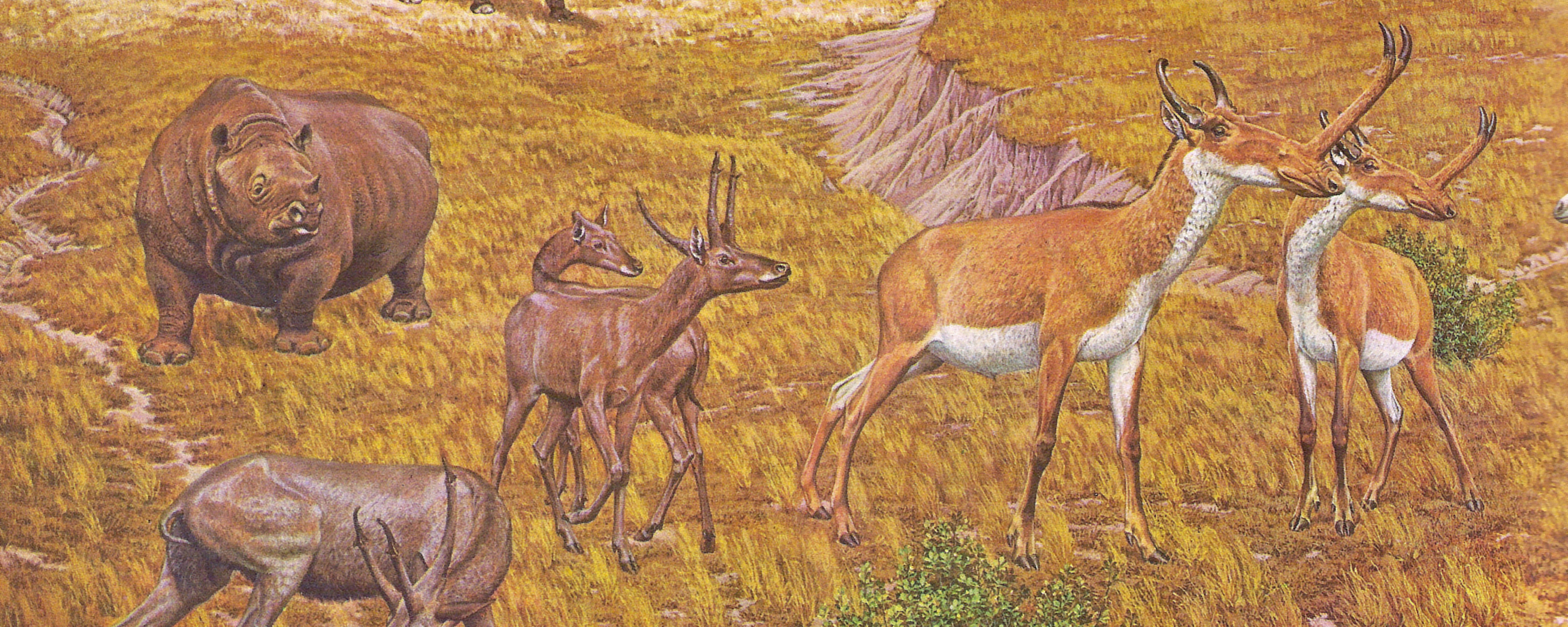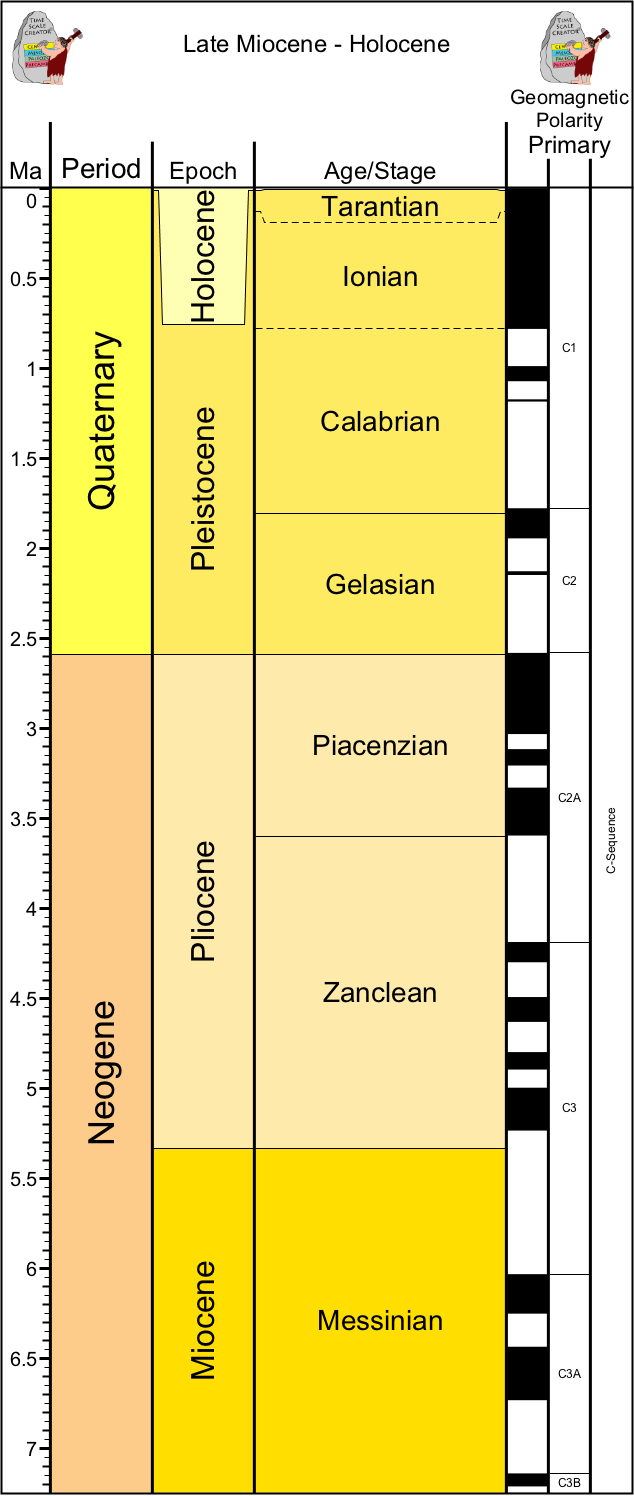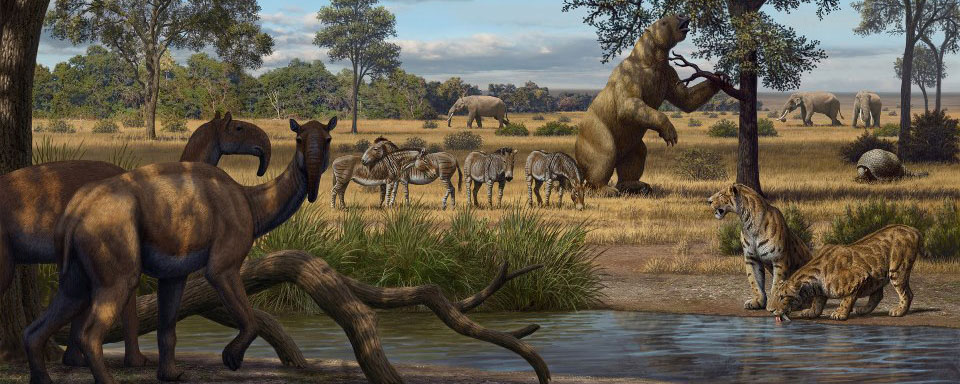


"Home, home on the range
Where the deer and the antelope play.
Where seldom is heard
A discouraging word
And the skies are not cloudy all day." -- John A. Lomax's 1910 version of the Dr. Brewster M. Higley poem "Oh, Give Me a Home Where the Buffalo Roam",
which became the lyrics of Kansas' state song "Home on the Range"
"The gigantic quadrupeds, the Mastodons, Elephants, Tigers, Lions, Hyenas, Bears, whose remains are found in Europe from its southern promontories to the northernmost limits of Siberia and Scandinavia...may indeed be said to have possessed the earth in those days. But their reign was over. A sudden intense winter, that was also to last for ages, fell upon our globe; it spread over the very countries where these tropical animals had their homes, and so suddenly did it come upon them that they were embalmed beneath masses of snow and ice, without time even for the decay which follows death." -- Louis Agassiz (1866) Geological Sketches
BIG QUESTION: How did mammals diversify after the K/Pg Mass Extinction? How did they respond to a cooler, drier, grassier world?
The World for World is "Forest": Early Cenozoic Mammal Radiations
The small body size and burrowing habit probably favored mammalian survival relative to dinosaurs and pterosaurs, for instance. Mammal species diversity and body size both increase very quickly after the dust settled and the Cenozoic began. Indeed, the placental mammal diversification of the Paleocene Epoch is the original case study of the concept of "adaptive radiation."
The global environment of the early Cenozoic (Paleocene and Eocene Epochs) was warmer and wetter than the modern world, not terribly dissimilar to the previous Cretaceous. Rain forests were common in many regions--even in the mountains of the American West. In the mid-Eocene it was warm enough that the Arctic Ocean in summer was covered by floating Azolla ferns. (In fact, over the space of 800,000 years the annual sinking and sequestering of these seasonal blooms in Arctic Ocean sediments drew atmospheric CO2 levels down from 3500 ppm to 650 ppm.)
The continents of the dawn of the Cenozoic were more separated than at present. As a consequence different continents were biologically isolated. As today, Australasia was an "island continent" (although connected to Antarctica, at least in the beginning), but South America, Africa, Madagascar, and India also lacked direct contact to other landmasses.
A consequence of this was that in the early Cenozoic there was a high rate of endemism (taxa unique to just one landmass). As today, Australasia was dominated by marsupials. Different groups of marsupials and non-marsupial metatheres (which were the dominant predators), as well as specialized endemic placentals. (Curiously, although marsupials are a Southern Hemisphere clade, Metatheria in the Cretaceous is only found in the Northern Hemisphere!)
The remaining regions were all dominated by various types of placentals. North America, Europe, and Asia had some limited connection, so many of the same clades were found in all three. Africa, India, and Madagascar were isolated; later in the Cenozoic the first two collide with Eurasia and there is an exchange of mammals and other animals.
As mammals evolved into apex predators, they required a new specialization: carnassials (shearing premolars and/or molars). This allowed them the slice of large chunks of meat, which ancestral teeth of mammals were not able to do. Carnassials evolved independently in the Sparassodonta (a South American clade of predatory stem-marsupials), in predatory crown-marsupials of Australasia, in "creodonts" (a paraphyletic assemblage of mid-Cenozoic carnivorous placentals in America, Eurasia, and Africa), and in Carnivora (the main clade of placental carnivorous mammals).
To give an example of the diversifications during the Paleocene and Eocene:
With isolation on different landmasses, convergences between different groups are rampant among Cenozoic mammals. Different clades evolve similar body forms due to similar life habits.
In the end of the Eocene the world began to dry and become colder. This transition is extremely quick (taking less than 100,000 years). The primary driver for this is the break up of Antarctica from Australia, forming a circumpolar current and the generation very cold bottom water. This cold bottom water (the Antarctic Bottom Water) is a major CO2 sink, sucking much of the carbon dioxide out of the atmosphere. This cooling of the world resulted in the first Antarctic glaciers.
This event resulted in some extinction events of marine plankton and a major turnover of mammals. In Europe this is called the Grande Coupure ("Big Break") and in Asia and the "Mongolian Remodelling". Throughout the world many early Cenozoic groups die out.
A group that begins to thrive at this time is the grasses. The Oligocene Epoch (33.9-23.03 Ma) saw the rise of grasslands, at least in the form of desert grasslands (primarily taking over from both desert scrub and dry woodlands.) During the Miocene (23.02-5.333 Ma) short grasslands with deep soils really start to take over, and in the late Miocene and Pliocene (5.333-2.588 Ma) we see the spread of tall grasslands with exceedingly deep soils.
Grasslands are one of the most important modern biomes. There are many types and names for these: savannas and veldts of Africa, prairies of North America, pampas of South America, steppes of Eurasia, rangelands in general, etc. (Generally, savanna is used for grasslands with scattered trees, and some other terms for those few or no shrubs and trees.) (Incidentally, woodlands are generally biomes where there is >40% woody plant cover, typically smaller trees where the crowns of the trees do not overlap; while forests are biomes here there is >>40% wood plant cover, where the trees can be more than 20 m tall, and where the crowns of the trees do overlap (and thus small ground cover plants receive very little sunlight.))
Approximately 40% of the modern land surface is covered by some form of grassland. Grasslands typically have very deep soil (in large part because of the rapid turnover of plants). Grasslands are typically associated with dry but not desert conditions: only 500-900 mm/yr rain.
Most of the grassland plants (both grasses and herbs) are annuals (live for just one year), so there is very rapid turnover of plants and thus VERY high productivity. In contrast, forests are dominated by trees which are decades-to-centuries old, and thus nutrients are sequestered in the plant biomass. In addition, although a given unit area of forest might have much more volume of plant matter, the great bulk of that is in the form of woody tissue which is not directly edible to typical vertebrates; in contrast, a very high percentage of a given grass plant is edible. As a consequence of rapid turnover and high percentage of accessible food, grasslands can support vast large vertebrate biomasses.
Fires are very, VERY common in grasslands. In fact, fires promote the maintenance and spread of grasslands, because grass can recover easily from fires, but trees and shrubs typically will need to recolonize in order to be present.
The changing of the environment resulted in major changes in the mammalian communities. To vertebrate zoologists, "grazer" specifies a grass-eater. (That is in fact the etymology of the word!) (Note however that marine biologists use "grazer" for almost any animal that bites off small immobile food, such as algae, polyps, bryozoans, etc.) "Grazers" is contrasted with "browsers" (animals that eat mostly herbs or the leaves of shrubs and trees), with "mixed feeders" as having both grass and browse in their diet.
It had long been observed that the Cenozoic saw a drying of the planet, and a shift from a forest-dominated to a grass-dominated world. Certain adaptations in mammal lineages (such as the evolution of equids (horses), bovids (antelopes, including buffalo, bison, cows, goats, sheep), and the like) were thought to document evolutionary responses to this environmental shift. Grazers are distinct from browsers in a number of aspects of the jaws and teeth:
There are other proxies for grazing vs. browsing. For example, if you look at the surface of teeth under the microscope, browsers typically have fewer scratches and more pits, while grazers have more scratches than pitting. Also the isotopic signal of C4 grasses (about which more below) show up in the chemical composition of the bones and teeth of grazers.
Some other changes from the ancestral forested home to life of the grasslands are tendencies but are not absolute distinctions: you can find some forest dwellers with these adaptations, too:
Many types of mammal (and other animals, to be fair!) diversified in the grasslands, but some of the greatest successes were among the ungulates: in particular, the Artiodactyla (the even-toed ungulates) and the Perissodactyla (the odd-toed ungulates). Indeed, within these two groups, there was huge diversifications in the Bovidae and the Equidae (respectively), both of whom were ancestrally forest-dwelling clades. The evolution of the equids in particular are an excellent example:
It is worth bringing up an issue of the geography in the mid-Cenozoic:
Now, a little stratigraphy:

The most recent Period of Earth History is the Quaternary. Based on our modern stratigraphy, it began at 2.588 Ma with a shift from an Icehouse to an Ice Age world, and the start of the glacial-interglacial cycles. The time between the onset of the glaciation and the most recent deglaciation is the Pleistocene Epoch, and the time of the recent interglacial (including this moment right now, and now, and now...) is the Holocene Epoch. Overall, Quaternary climates are cold by Earth History standards: even the interglacials of the Pleistocene and Holocene are cooler than the preceding Pliocene and Miocene times, much less the Greenhouse world of the Eocene and earlier.
The Pleistocene has a characteristic fauna. We'll encounter the Pleistocene fauna of many other parts of the world in a future lecture; for this one we will concentrate on boreal (northern) Eurasia. Some of the more famous and dramatic were:
These animals survived repeated glacial-interglacial episodes, moving North and South to track the cooler (but not fully glaciated) conditions they preferred.
The Pleistocene saw two major new biomes show up. The tundra is a lowland, generally coastal environment. The vegetation is often descended from mountain species, and are very low to the ground. It dominates the polar regions today. However, during most of the Pleistocene the cold environment was dominated by the mammoth steppe. This was dominated by grasses rather than low flowers, and had much higher diversity of plants (and of animals feeding them). Mammoth steppes had much higher productivity than tundra does. They required mammoths and other large animals to form: these fertilized the steppes with their feces, and exposed soils which allowed for various plant species to colonize and grow.
The boreal mammalian community was famously the Age of the Woollies: animals with thick heavy furs. Many show dry land feeding adaptations (high-crowned teeth, etc.), especially in the mammoth steppes. They often had shorter and stockier limbs than their southerly kin, and larger bodies (and thus having a lower surface area/volume ratio, and thus retained heat better.)
But where did they come from? Some had origins from the Pliocene species that lived in the same region. For instance, woolly mammoths seem to be the descendants of the steppe mammoth Mammuthus trogontherii , itself descended from the Southern Mammoth Mammuthus meridionalis. Cave lions seem to nested phylogenetically within the lion-like panthers (lions and leopards), which were still living in the temperate zone (even Europe) in early historic times. And so forth.
But a new set of discoveries were made in the Tibetan Plateau in the last decade. The vast elevated Tibetan Plateau is sometimes called the "Third Pole". The conditions there are similar to polar regions due to the extreme cold.
A series of joint US/Chinese expeditions in the Zanda Basin have explored lake deposits containing abundant mammal fossil remains. These range from the late Miocene through the Pleistocene. They document several important discoveries:
In fact, there are some animals from the Zanda Basin fossil record whose descendants were to spread to other parts of the world, such as:
The "Out of Tibet"/"Third Pole to the North Pole" hypothesis is compelling: after all, animals adapted to the cold Tibetan Plateau would do fine when the world began to chill. The Zanda Basin expeditions are on-going, so we will see what other Pliocene precursors of Pleistocene mammals may be discovered.
But what of Cro-Magnons, Neanderthals, and the like? Their story takes us back not to Asia, but to Africa.
